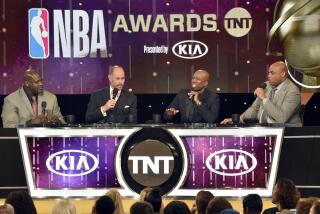Give Bill Sharman a Lot of Points for Finding Range With This Idea
- Share via
I have found the guilty party.
I have located the fugitive who is wanted for subverting and corrupting the respectable game of basketball, the man responsible for jacking up the entertainment and excitement factor by a couple big notches, causing all kinds of problems. Just ask UCLA.
If you happen to think that the three-point shot has ruined basketball, blame it on Bill Sharman. He’s the guy.
Blame Bill Sharman for Fennis Dembo and Steve Alford and Michael Cooper and Detlef Schrempf and UNLV and the Dallas Mavericks and all the other players and teams who have turned the three-point shot into a weapon.
Those of us who actually love the three-pointer would like to see the government print a three-dollar bill and put Sharman’s picture on it. If he isn’t the father of the three-pointer, he’s at least co-father.
Sharman is the genial president of the Lakers. He is significantly responsible for building the Laker dynasty. You don’t hear much about him these days, or from him, because Bill blew out his voice coaching and yelling the ‘71-72 Lakers to a 33-game winning streak and an NBA title. The voice has faded to a whisper, but through a series of back-and-forth letters with him, I learned the story of the birth of the bomb.
“To the best of my knowledge, Abe Saperstein was the first to suggest, and was eventually responsible for, the three-point basket,” Sharman writes. “The first I heard about it was during the 1960-61 season, which was my last with the Boston Celtics. The Harlem Globetrotters (Saperstein’s team) were in Boston and I was watching them play. Abe came over to me and mentioned that he was going to start a new professional league next season, to be called the American Basketball League. . . . He said he wanted to include a three-point shot 25 feet from the basket that he would call the home run of basketball. . . . I said it sounded great, and wished him a lot of luck.”
If the home run was Abe’s idea, it was Sharman’s research and relentless campaigning that made it a reality. It started when Sharman accepted an offer the following season to coach an ABL team, the L.A. Stars.
“After arriving and getting set up in Los Angeles, one of the first things I did was take a measuring string and draw a chalk circle 25 feet from the center of the basket,” Sharman wrote. “I could tell almost immediately it was going to be too far out to be useful or effective in a game. After trying a few shots, I was definitely convinced that it would not be viable, and should be moved in. Accordingly, I immediately started a campaign to bring the three-point line in closer.”
Sharman badgered the other ABL coaches into badgering Saperstein to move the line into more realistic range.
“However,” writes Sharman, “Abe was very determined to call it the 25-foot home run ! After much discussion and a few heated arguments, we finally convinced him that we could measure the distance from behind the basket instead of from the middle of the hoop, and still call it the 25-foot home run.
“So this brought the line in about 18 inches (15, actually), which helped a great deal, and it remains that distance in the NBA today.”
Had Saperstein not relented, the new idea would have died quickly. Instead, it caught on with fans and players in the ABL, which became the ABA. When the ABA died, the NBA stole the three-point idea, starting in 1979.
Sharman-coached teams won championships in the ABL, ABA and NBA, so, hey, maybe the guy does know something about basketball, other than how to play it (he was an eight-time NBA All-Star with the Celtics).
Critics have hit hard at the three-pointer since the very beginning, calling it a circus shot, a prostitution of the game. From the beginning, Sharman has been the most tireless and effective champion of the home run. When the NBA adopted the shot, the college purists puffed out their chests in self-righteous indignation.
So what happens? This season the college people paint a home-run line on their court, four feet inside the NBA line. Reviews have been mixed, but not everyone phoned their travel agent to book a flight the day after the Wright Brothers buzzed Kitty Hawk, either.
College coaches hate the shot, which is a solid indication it’s a great idea.
I thought the college line was too close, but now I think I like it. The NBA bomb is still beyond the range of the vast majority of shooters, but the college three-pointer has become an effective weapon for many teams. UCLA lived, and ultimately died, by the bomb.
The shot has opened up the college game, which now tends to look less like 10 guys arm-wrestling in a phone booth. This is good for the little guys and the big guys. And the fans.
The three pointer is here to stay, but is Sharman happy? Will he leave the game alone now?
“I still think the NBA shot could be improved,” he writes. “I feel they should move the line in about a foot to make it a more viable part of the team’s offense. Then they could start designing some plays and patterns that would become part of the team’s regular system.”
The man is a troublemaker.
More to Read
All things Lakers, all the time.
Get all the Lakers news you need in Dan Woike's weekly newsletter.
You may occasionally receive promotional content from the Los Angeles Times.






